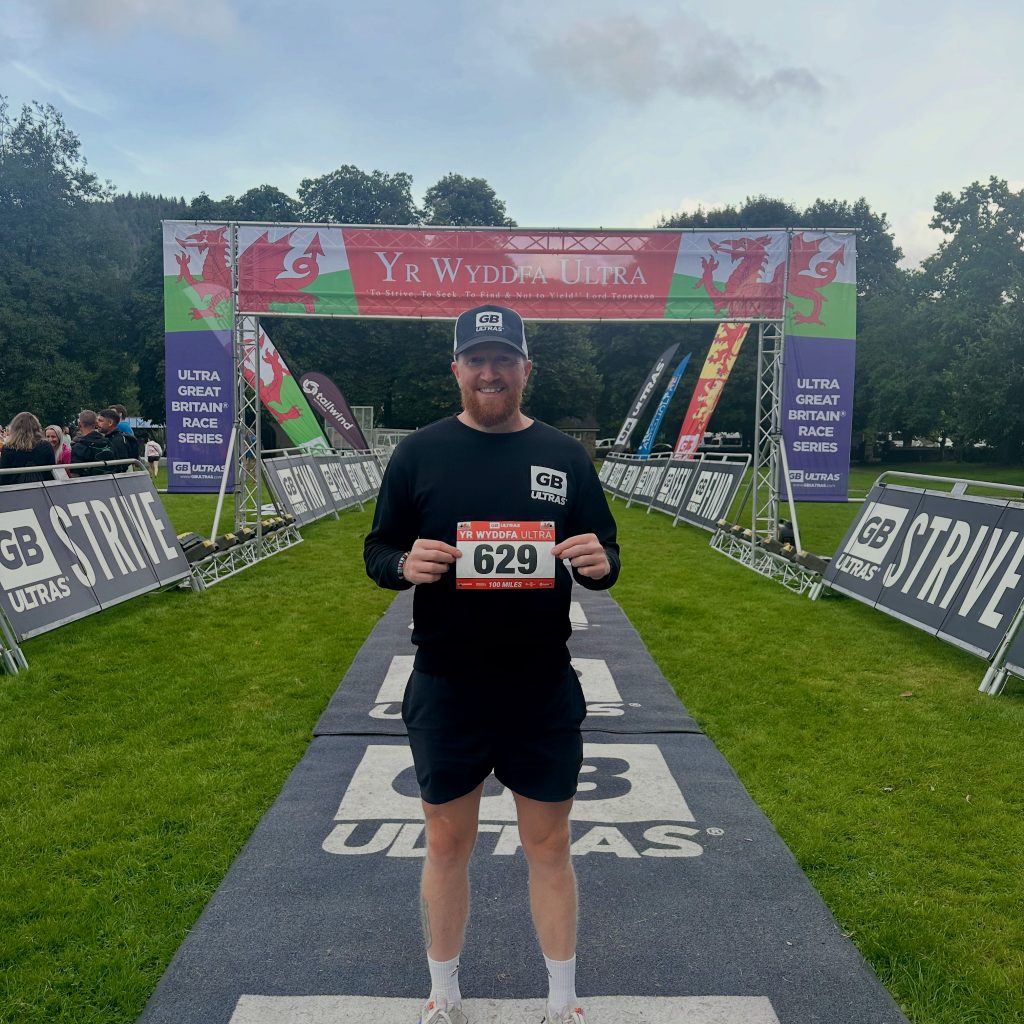
I arrived Friday at lunchtime, checked into my hotel, and dropped off my bags. After helping the GB Ultras team set up the race HQ, I grabbed a pizza, then returned to my room to organise my race kit and drop bags. Registration started at 5:30pm, so I picked up my race number, caught up with friends, and had an early night before race day.
In bed by 9pm, I managed to get a good 6 hours’ sleep, which is quite rare for the night before a big race, usually nerves and anticipation keep me tossing and turning. My alarm went off at 4:20am, and after a few moments of gathering myself, I got up and took a hot shower to wake up properly and loosen up my muscles. I put on my race kit, making sure everything fitted comfortably and there were no niggles or chafing points that could cause issues later in the day.
Breakfast consisted of porridge with honey and a banana, along with a strong coffee to get my energy levels up and help with pre-race focus. I double-checked my starting kit and race pack, making sure mandatory kit items like waterproofs, headtorch, map, compass, and emergency food were all in place. I also checked that my nutrition and hydration supplies were accessible, topping up my soft flasks with electrolytes and filling my bottles with water. Satisfied everything was in order, I zipped up my pack and headed out into the early morning darkness.
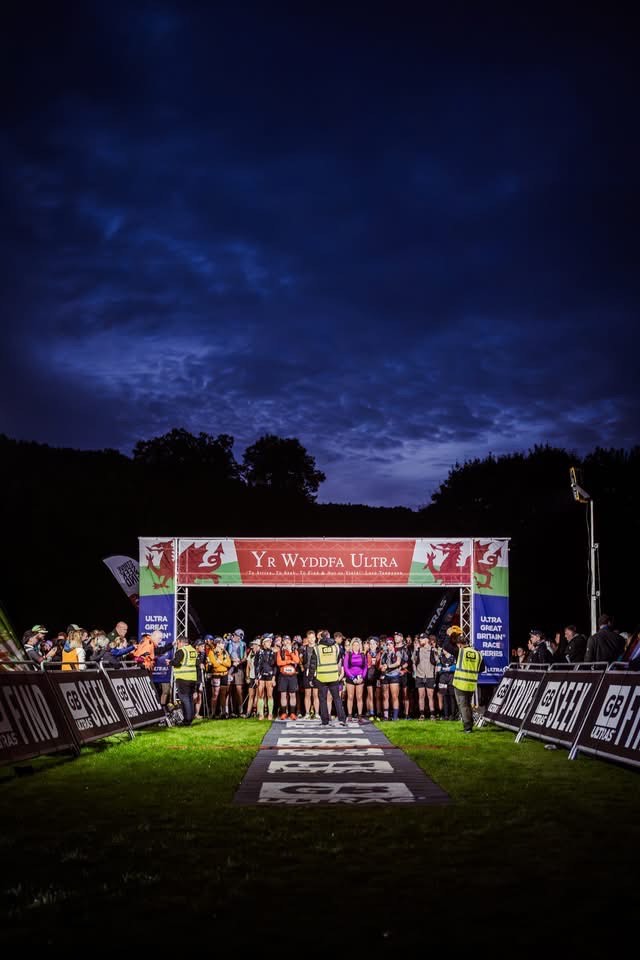
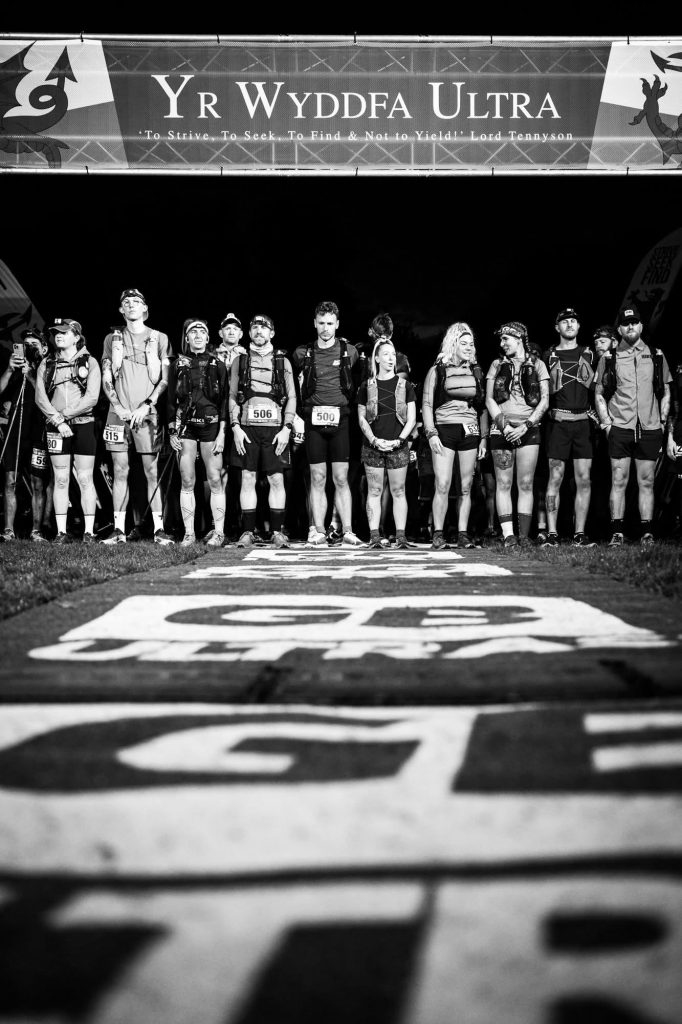
On arrival at the race HQ, the buzz of pre-race excitement was already building. I collected my GPS tracker from the desk and secured it to my pack. Next, I handed in my two drop bags at the designated area, this was my first time relying on drop bags rather than a crew, so I’d packed them carefully with extra socks, gels, food, spare layers, spare trainers, a fresh headtorch battery, and even a bottle of Lucozade for a morale boost later in the race. With everything sorted, I joined the other runners at the start line, feeling a mix of nerves and anticipation as the day’s adventure lay ahead.
We gathered on the start line, a collection of headtorches bobbing in the early morning gloom, nervous chatter and laughter filling the air as runners made final checks to their packs and exchanged good luck wishes. The weather was mild, with a gentle breeze and just enough chill to keep us alert, while a blanket of low, grey clouds held off any threat of rain, ideal conditions for a long day in the mountains. I was relieved that we’d been spared baking sunshine or relentless downpours, and there was a cautious optimism among the group.
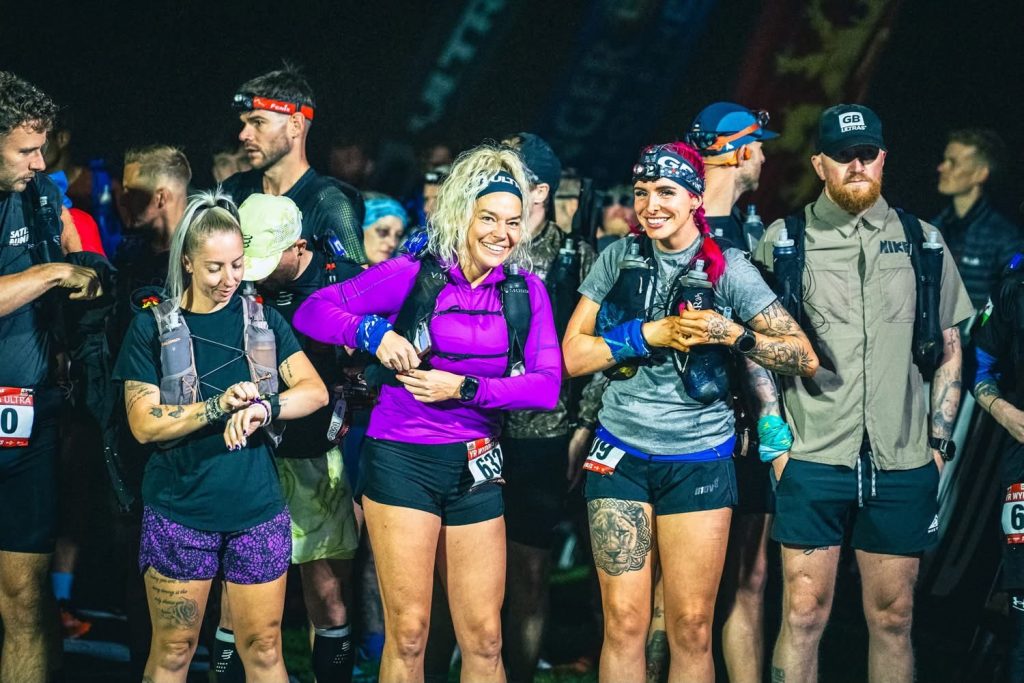
The forecast had promised similar conditions for most of Saturday, but there was a caveat: strong gusts of 40-50mph were expected at the higher summits as the day wore on. Because of this, the race directors, after careful consultation with the mountain safety team, had made the wise decision to divert us onto the event’s established low-level route for the opening climb, avoiding the exposed ridge of Tryfan. This change meant we’d miss the dramatic views from the ridge, but safety always comes first in these wild places, and I could sense a mixture of disappointment and relief at the same time among the runners as the announcement was made.
As 6am approached, the anticipation grew. Watches were synchronised, GPS trackers checked, and nervous energy filled the air. Wayne & Ian gave their final briefing. Then the countdown began, ten, nine, eight, voices joining together, heart rate increasing, adrenaline building. At zero, a cheer went up, and we surged forward into the dim light, and the adventure began in earnest, setting off into the heart of Eryri’s rugged landscape.
Start to CP1 (Gwern Gof Isaf) – 8.5 miles
This event marked my fourth 100-mile ultra of the season, each forming part of the GB Ultras grand slam. With that in mind, I was determined to begin carefully, setting off at a deliberately slow pace to ease myself into a controlled rhythm. My main goal was simply to complete this race and, in doing so, achieve the grand slam.
The route began by winding through the picturesque village of Betws-y-coed, its quaint streets still quiet in the dawn light. We over the old bridge, following the course of the river as it snakes alongside the A5 road and towards the heart of the Eryri (Snowdonia) national park. The slate trail offered a scenic backdrop, with the sound of the river providing a calming counterpoint to the pounding of our feet and the steady hum of conversation between runners.
The initial terrain was challenging, with a tangle of tree roots crisscrossing the path and stretches of uneven, rocky ground demanding constant attention to foot placement. These early miles required a degree of agility and focus, as the risk of a twisted ankle or early stumble was real. Despite this, the trail soon transitioned into more forgiving terrain, a mix of gravel roads, wide pathways, and open fields. These sections allowed for a more relaxed and runnable pace, giving me the chance to find my stride and settle into the rhythm of the race. The gentle undulations and the stunning green surroundings were a reminder of the beauty of the Welsh countryside, and I took a few moments to appreciate the scenery as we pressed on.
After several miles, we reached the road crossing at Capel Curig. This spot marked a transition not just in terrain but in the flow of runners. As I made the crossing, the leaders of the 50-mile race began to come through at an impressive pace. Their race had started just 15 minutes after ours, yet it had taken them only about half an hour to catch up and overtake me.
The final stretch into the first checkpoint was a couple of kilometres of undulating track, with gentle rises and falls that kept the legs engaged but were still very runnable. I kept my effort measured, resisting any temptation to push too hard this early in the race, instead focusing on conserving energy for the challenges ahead.
Arriving at CP1 at Gwern Gof Isaf, I felt in good spirits and still fresh. The checkpoint was bustling with volunteers and runners, but I didn’t need too much at this stage. I quickly topped up my bottles and grabbed a banana for a quick energy boost, exchanging a few words with the friendly crew. With minimal delay, I set off once more, ready to tackle the first substantial climb of the race that awaited just beyond the checkpoint, knowing the real test was about to begin.
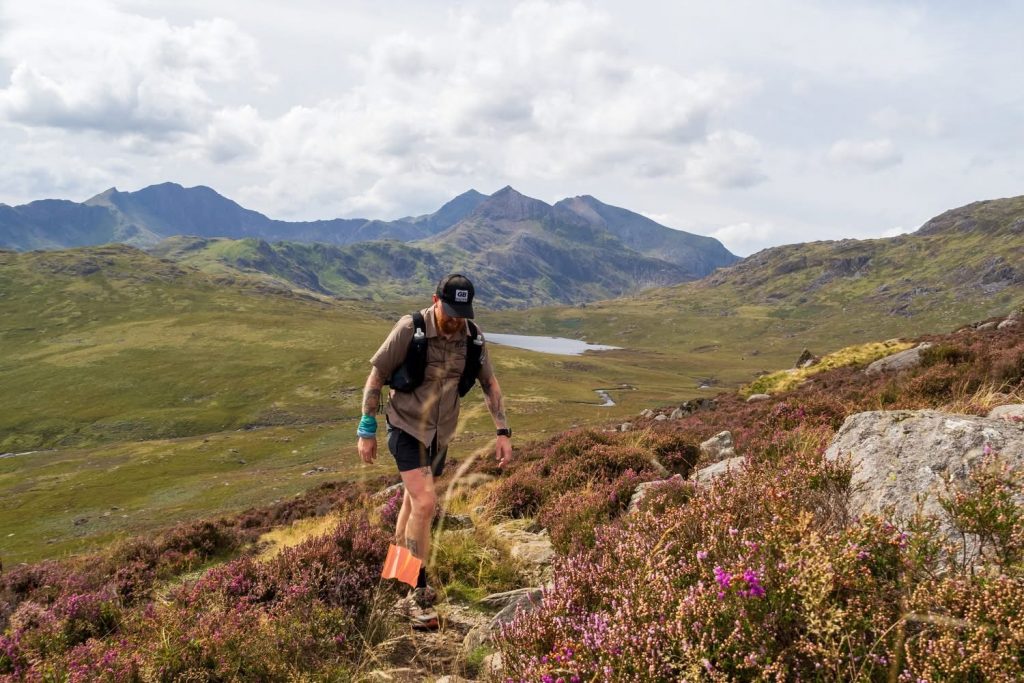
CP1 to CP2 (Pen-y-Gwyrd Hotel) – 13 miles
Leaving CP1, I took a moment to look up at the imposing silhouette of Tryfan, the rocky peaks standing out in the clear sky. There was a strange duality to my feelings, a twinge of disappointment at missing the dramatic ridge traverse, and a simultaneous sense of relief knowing we’d be spared the brunt of the forecast 50mph winds. The low-level diversion, however, was far from a gentle alternative. I quickly realised that while we’d avoided the exposed ridge, the route still demanded a climb of approximately 700 metres, winding through rugged, undulating terrain that offered its own set of challenges.
The early stages of the climb took us along a twisting track, the path gradually narrowing as it rose from the valley floor. The footing was tricky in places, with loose scree underfoot and scattered rocks requiring careful attention. The morning’s mild air felt noticeably cooler as we gained elevation, a fresh breeze swirling across the open hillside. I kept my pace measured and deliberate, determined not to squander energy so early in the race, especially with the knowledge that two major climbs still lay ahead. Around me, the group began to spread out, with some runners striding confidently ahead while others, like myself, settled into a sustainable rhythm.
Despite being dubbed the “low route”, there were several sections that allowed for steady running, and I made use of these to tick off some miles, enjoying the rare moments when the path levelled out. As we climbed higher, the landscape opened up, revealing sweeping views back towards Capel Curig and the patchwork of green fields below. At the point where the trail split towards the Glyder range, the route delivered its first real test of the day: a lengthy stretch of sodden, boggy ground. The recent rain had left the ground waterlogged, and with each step my feet sank deeper into the mire. I’d hoped to keep my shoes dry a little longer, but that was wishful thinking, within moments my socks were soaked through.
Once through the bog, the descent towards CP2 began. The initial drop was relatively gentle, with winding paths threading between heather and boulders. As I picked my way down, I could see a string of cars glinting in the distance along the roadside, a sure sign the checkpoint wasn’t far off. Here and there, the gradient steepened unexpectedly, the path slick with mud and rainwater, and I quickly learned that appearances could be deceptive, what looked like a fast, runnable section could easily turn into a slip hazard. I witnessed a couple of runners take tumbles, their feet sliding out without warning, and reminded myself to take it easy. The last thing I wanted was a twisted ankle or worse, especially with my grand slam hopes hanging in the balance on this final ultra.
Eventually, the path levelled out as I neared the checkpoint. Volunteers greeted us cheerfully, and the checkpoint bustled with runners grabbing supplies and refuelling. I wasted no time in filling my bottles, taking the added precaution of topping up a third bottle in anticipation of the big climb to come, the much-anticipated ascent of Yr Wyddfa (Snowdon). I made sure to grab a handful of fruit, a bag of crisps, and a sandwich, knowing that nutrition would be crucial for what lay ahead. Spirits were high as I left CP2, the sense of camaraderie among the runners palpable, and I pushed on with growing excitement towards the next, and perhaps most iconic, challenge of the race.
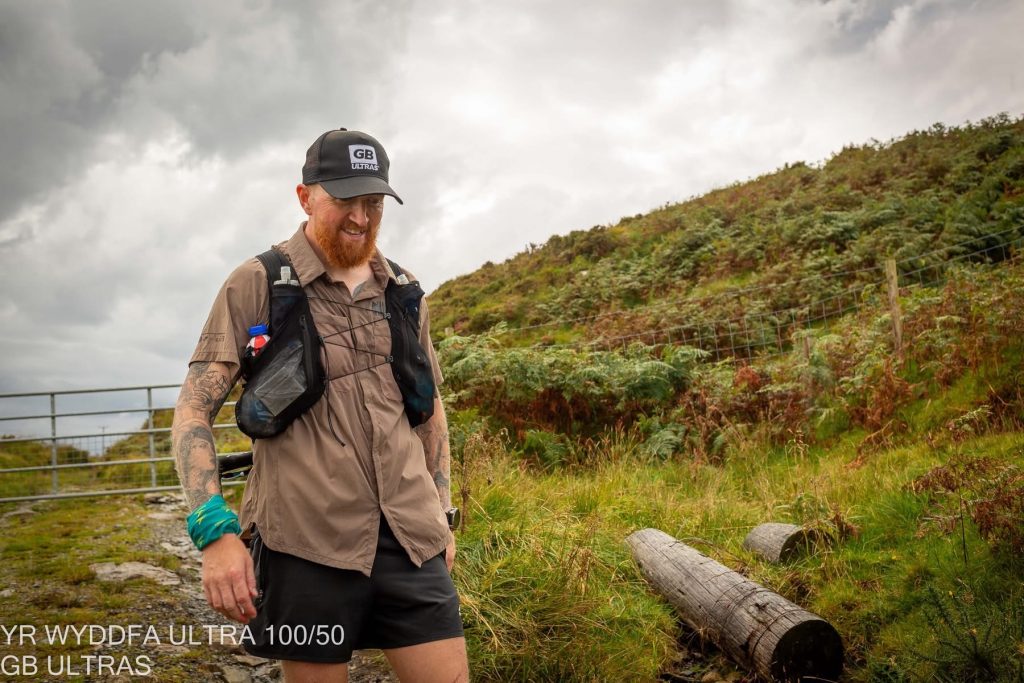
CP2 to CP3 (Pen-y-Gwyrd Hotel) – 23 Miles
Leaving CP2, my energy levels remained solid, but now, with each step, I became increasingly aware of a familiar ache in my right heel, a reminder of the plantar fasciitis that has plagued me throughout the year. Still, I took comfort in the fact that the discomfort had only started to make itself known after around 25 kilometres, a marked improvement compared to the ongoing battle I endured during the entirety of the Beacons Way 100-miler just a month earlier.
The initial stretch leaving CP2 consisted of a long, gradual ascent towards Pen-y-pass. The path was predominantly rocky underfoot, weaving between weathered stone slabs and loose scree, demanding careful foot placement and a measured pace to conserve energy. The climb itself was steady rather than punishing, but the relentless gain in elevation and the rough terrain meant I had to stay focused. I found myself settling into a rhythm, breathing in the crisp mountain air as I moved ever upward.
Upon reaching Pen-y-pass, the route joined the iconic Pyg Track, which, as expected, was alive with the energy of hikers and families. The trail was noticeably busier, with clusters of people pausing for photos, adjusting backpacks, or simply catching their breath. This influx of day-trippers added a social dynamic to the climb; I exchanged nods and snippets of encouragement with fellow adventurers, each of us pursuing our own challenge on the slopes of Snowdon. The Pyg Track itself was immediately steeper, with sections requiring hands-on scrambling over large boulders and uneven steps carved into the rock.
As I gained height, the views expanded dramatically. To my right, the jagged, knife-edge ridge of Crib Goch presented a striking silhouette against the sky, while ahead and to the left, the summit of Snowdon loomed, shrouded in light cloud. The anticipation of those famous 360-degree views kept me motivated, and I hoped the mist would clear in time for my arrival at the top. The next segment of the path was more forgiving, a brief plateau with a gentle gradient allowed for some running, and I seized the opportunity to stretch out my legs, making up time before the final push.
Nearing the summit, the Pyg and Miners’ Tracks converged, funnelling all traffic onto a single, narrower section. The crowding intensified, and the path transformed into a blend of rocky steps and steep scrambles. Here, alertness was essential, not just for the terrain, but to avoid collisions with other climbers navigating the same obstacles. The final approach before meeting the Llanberis Path was especially technical, with loose stones underfoot and a couple of tight switchbacks. I focused on controlled movements, mindful of my heel pain, and kept my pace steady, gently threading my way through the bottleneck.
Emerging onto the Llanberis Path for the last few hundred metres, I felt a surge of relief and accomplishment. The summit itself was windswept and lively, with runners, hikers, and tourists all pausing to soak in the panoramic views. I took a brief moment to take a couple of photos, savouring the views stretching across the whole national park.
Turning to descend, I took advantage of gravity, eating and drinking as I navigated the technical upper sections. The descent down the Miners’ Track was at times slow-going due to the slick rocks and congestion, but I embraced the opportunity to recover and refuel. As the path levelled out, I picked up speed where possible, weaving past groups and watching my footing carefully to avoid any mishaps. The route eventually led back to Pen-y-pass and then rejoined the familiar track towards CP2, which now served as CP3 for this section of the race.
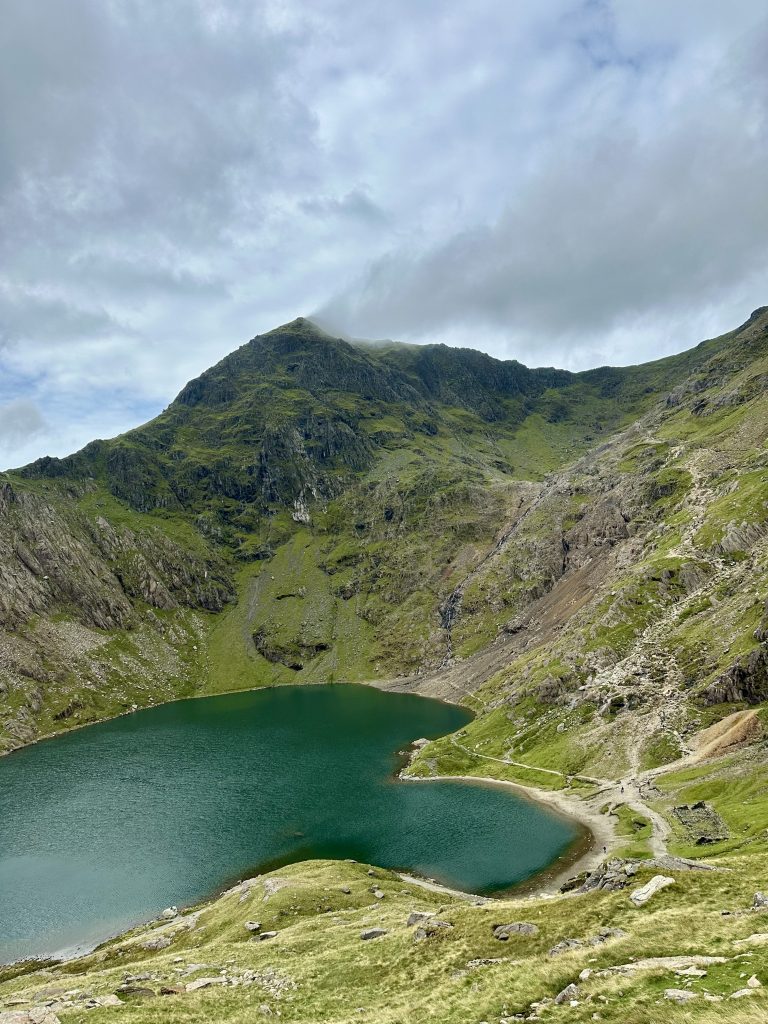
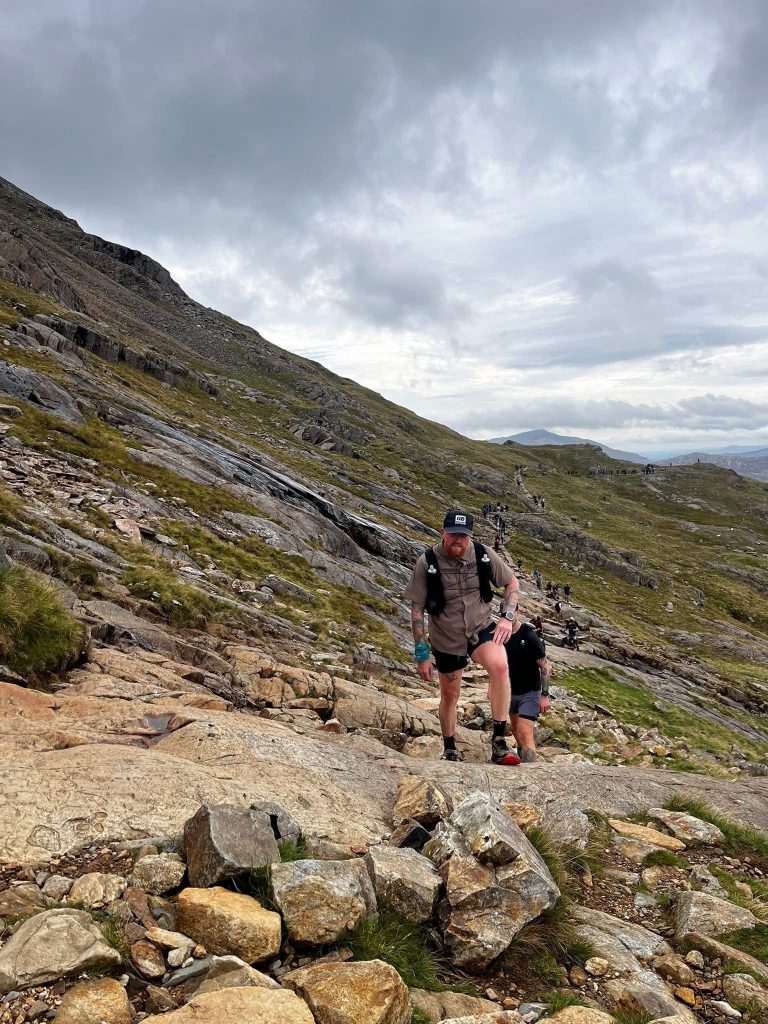
CP3 to CP4 (Pont Pen-y-Benglog) – 28 Miles
I didn’t linger at the checkpoint, opting for a swift turnaround, just enough time to refill all three of my bottles and load my pockets with a fresh supply of snacks. The volunteers were efficient and encouraging, their support much appreciated as I prepared for what lay ahead. With minimal fuss, I was back on the move, mentally bracing myself for the third of the big three climbs: the ascent to the Glyders. There was no gentle lead-in; the route left no room for respite, launching straight into a steep, relentless uphill from the very start.
The climb retraced the same boggy path I had descended earlier into CP2, my feet, which had only just begun to dry out, were soon soaked once more. The familiar squelch underfoot was a reminder of the ever-present marshes typical of this part of Snowdonia. Despite the soggy terrain, the weather held in my favour: the air was warm, with a thick blanket of cloud keeping the sun at bay, preventing it from sapping my energy. I capitalised on these conditions, pushing on steadily upwards, motivated by the knowledge that conquering this climb would mean all three of the major ascents were behind me. In the back of my mind, I entertained the hopeful thought that the remaining 70 miles might be mercifully flat, though experience told me otherwise.
The ascent itself was largely uneventful, marked only by the quiet camaraderie of fellow runners. We leapfrogged each other up the hillside, exchanging nods or brief words of encouragement as we paused for breath or to admire the views. The path wound up through a landscape that shifted from bog and heather to increasingly rocky outcrops. As I neared the crest of the Glyders, the terrain became markedly more technical, large slabs of angled rock and loose scree demanded full concentration and nimble footwork, especially now that the wind had begun to pick up. Still, this section remains one of my favourites: the landscape here is stark and dramatic, with jagged rocks jutting skywards, and the panoramic views stretching out in every direction, peaks and valleys fading into the misty distance, making it feel as though I’d landed on another planet entirely.
The descent via Devil’s Kitchen was, as always, a formidable challenge. The path here is steep and treacherous, a tangle of slick, uneven rocks and loose gravel. I could see and hear other runners struggling, many slipping, some taking tumbles, with cuts and grazes to show for their efforts. The descent required patience and precision. I took my time, picking my way carefully to avoid joining the ranks of those nursing fresh wounds. It meant sacrificing a bit of speed, but reaching the bottom in one piece felt like a victory in itself.
Once clear of Devil’s Kitchen, the trail levelled out, offering a rare opportunity to stretch my legs and regain some of the time lost on the descent. The path skirted along the edge of the lake, offering a welcome reprieve from the technical terrain. I settled into a steady rhythm, letting the relative ease of the terrain lift my spirits as I cruised towards CP4 at Pont Pen-y-Benglog.
Arriving at the car park, I was met with an unexpected surge of support, spectators and volunteers cheered, their encouragement providing a much-needed morale boost. The simple act of being greeted so warmly after a tough section of the race was invigorating, reminding me of the community that underpins events like these.
By now, however, the relentless pounding over uneven and rocky ground was beginning to take its toll. My feet were sore, the right heel in particular nagging with the familiar ache of plantar fasciitis. I paused briefly to take two painkillers and slipped off my shoes, stretching out and trying to ease the growing discomfort. The break was short, but it was enough to reset mentally before moving on, determined to keep the injury at bay for as long as possible.
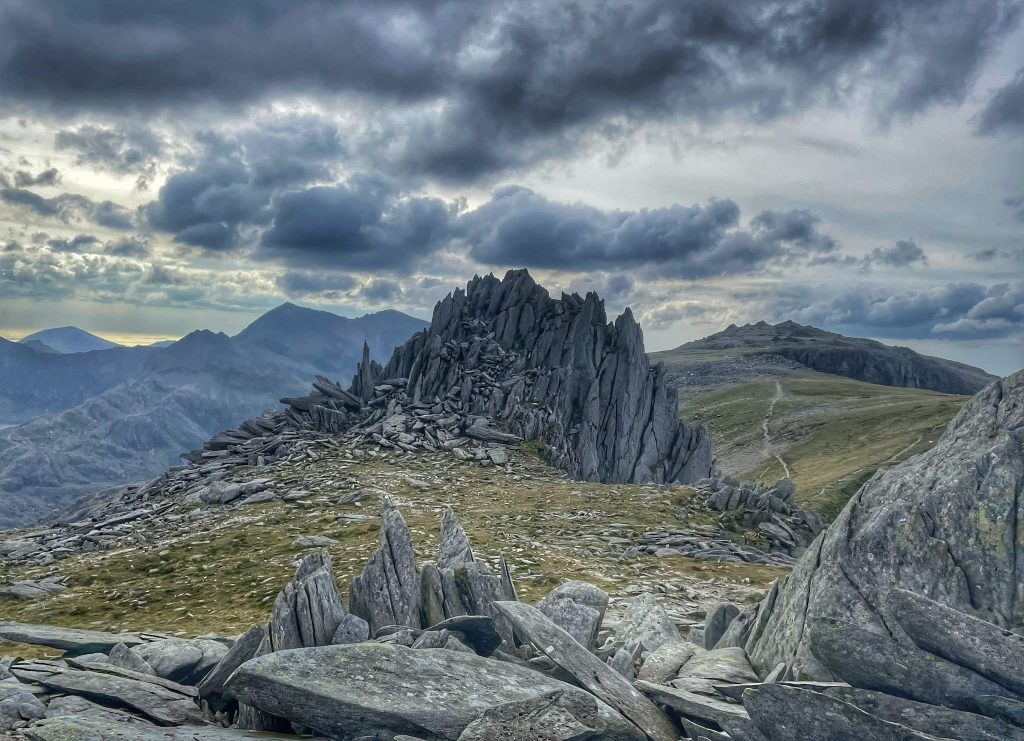
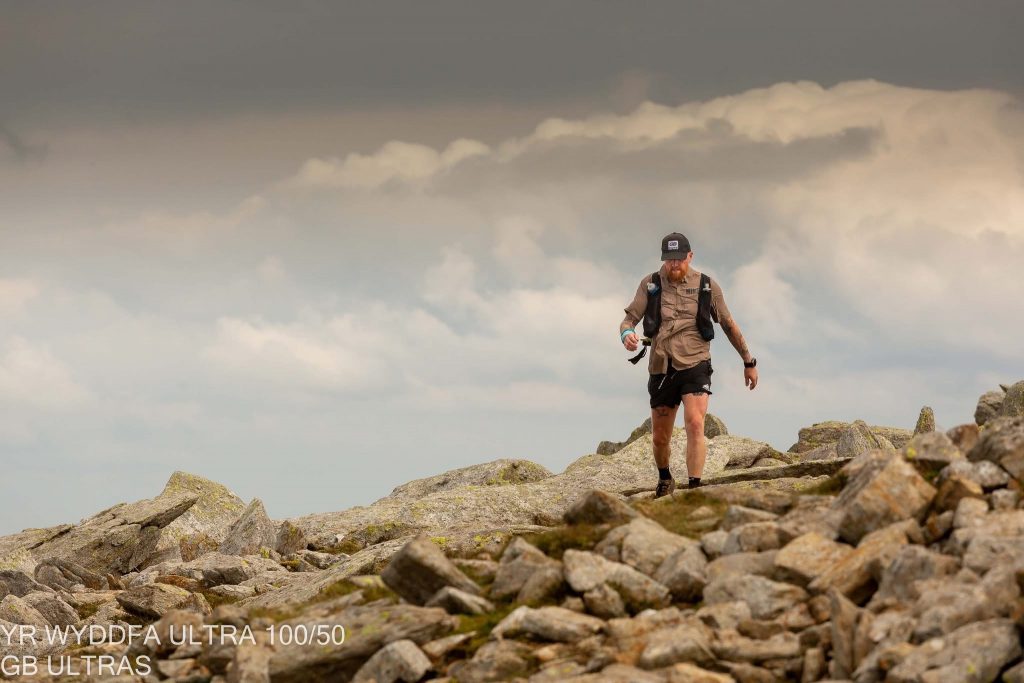
CP4 to CP5 (Llyn Crafnant Car Park) – 38 Miles
After taking a few moments to refill my bottles and replenish my snacks at CP4, I slipped my shoes back on. Determined not to linger and lose momentum, I pressed on, grateful for the brief pause and the morale boost from the supportive volunteers and spectators.
The next section was a welcome change from the punishing terrain I’d just endured. The trail traced the edge of Llyn Ogwen, the water shimmering in the late afternoon light and offering a tranquil backdrop to my steady progress. The path here was relatively smooth and undemanding, allowing me to settle into a comfortable rhythm. Occasionally, I glanced up to admire the rugged outline of the surrounding peaks, the landscape softened by the gentle glow of the lowering sun.
After skirting the lake, I crossed over the busy A5, before rejoining the familiar trail at the foot of Tryfan. It felt strange to be back on this section, retracing my earlier steps but in the opposite direction. The sense of déjà vu was oddly comforting, and I found myself picking up the pace, buoyed by the knowledge of what lay ahead.
I made the most of this relatively easy stretch, running much of it and overtaking several other runners who were either walking or tending to their own aches and pains. My confidence grew as I approached Capel Curig. The route then forked off to the left, leading onto a looped out-and-back section towards CP5 at the Llyn Crafnant car park. This part of the course was undulating but not overly taxing, with well-defined tracks winding through a patchwork of woodland and open moor. The trail was easy to follow, with clear markers and barely any technical obstacles, allowing me to focus on maintaining a steady cadence and efficient form.
As I drew closer to CP5, I realised I still had around two hours of sunlight left. This gave me a real psychological lift. From my previous experiences running the Snowdon 50, I remembered that it was usually at this checkpoint that I would put on my headtorch. The fact that I was making such good time this year, arriving at CP5 with light to spare and still feeling relatively strong, was hugely encouraging.
Of course, my heel injury hadn’t disappeared; if anything, the pain had been growing a little more insistent with every mile. Each footfall sent a dull throb up my leg, and I found myself adjusting my stride to compensate. Nevertheless, the sense of progress and the stunning scenery kept my spirits up. Setting myself a new mini goal, reaching CP6 before nightfall, gave me a fresh focus. I knew that at CP6 I would have access to my first of two drop bags, a chance to change into dry clothes, restock my nutrition, and take a proper break before facing the challenges of running through the night.
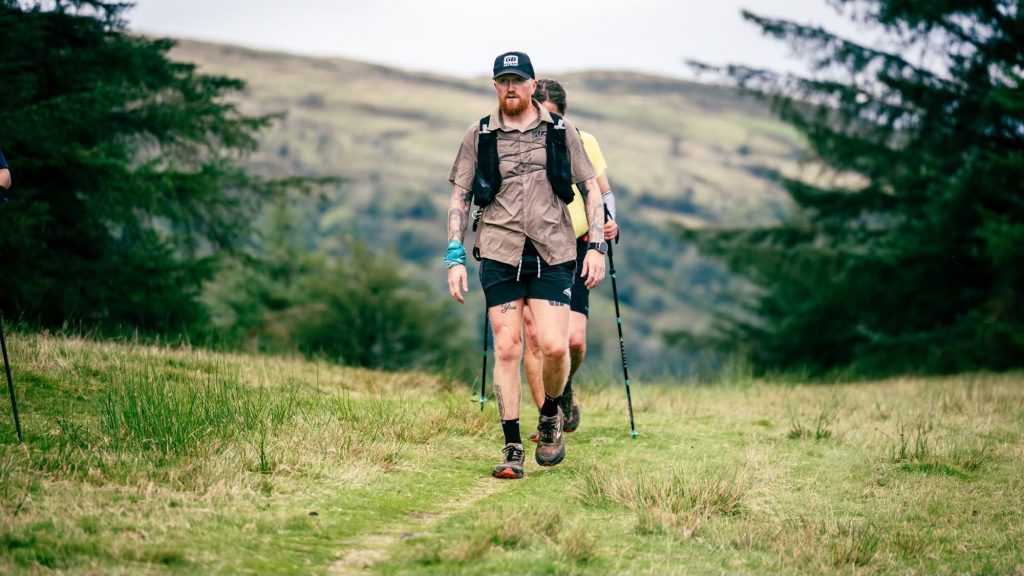
CP5 to CP6 (Betws-y-Coed Village Green) – 45 Miles
At CP5, I took a moment to rest, finally sitting down to take the weight off my aching foot while a friendly volunteer topped up my bottles. The pain in my right heel, which had been building steadily over the past hours, throbbed relentlessly. Determined not to squander time at the checkpoint, I kept my stop brief and efficient, mindful that I’d planned to save any small luxuries, like a proper rest, until later in the night, when mental fatigue would hit hardest.
The challenge of eating solid food was starting to rear its head. My stomach, unsettled from the constant motion and mounting exhaustion, threatened to rebel, and I had to force each mouthful down, reminding myself that fuelling was non-negotiable if I wanted to finish. I nibbled on some plain sandwiches, and a banana, hoping they’d stay down. The simple act of chewing took effort, but I knew from experience that skipping fuel now would only make the night stretch ahead even harder.
Leaving the checkpoint behind, I set off. The trail remained forgiving for a while, tracing the gentle curves of two waterways, their surfaces catching the last amber rays of sunlight as evening crept in. The route soon merged with the familiar slate trail, a ribbon of track I’d already navigated earlier that day when leaving Betws-y-Coed. I found the familiarity oddly comforting amidst the growing fatigue.
As I pressed on, the atmosphere around me shifted. There was an unmistakable urgency to the 50-mile runners heading towards their finish, the knowledge that their race was nearly over. Their energy was infectious: some offered quick words of encouragement as they overtook me, while others simply flashed weary smiles. I congratulated those I could, offering a few supportive words, but tried to keep my focus on my own race. Several times, I found myself momentarily swept up in their momentum, only to remember I still had another 55 miles to go; their finish line was just the halfway point for me.
As I neared Betws-y-Coed, the sounds of the bustling Saturday nightlife drifted through the trees, music, laughter, and the hum of conversation, reminding me that, for most, this was just another regular evening. The lights of the village glowed invitingly in the distance, growing brighter as dusk deepened to night. The contrast was surreal: the elation of the 50-mile finishers funnelled off to the right, their efforts rewarded by cheers, family embraces, and the promise of celebration. For us 100-mile runners, the path veered left, guiding us into the checkpoint with the sobering knowledge that we were less than halfway, with a full night of running and unknown miles ahead.
The mental challenge at this moment was immense. The temptation to stop was almost overwhelming, the sight of my car, parked tantalisingly close, offered the promise of warmth, comfort, and rest. I had to dig deep, reminding myself of my reasons for entering this race and the grit required to carry on when every instinct screamed to stop.
Inside the checkpoint, I found a quiet spot, removed my shoes and socks, and allowed my feet to dry out. The relief was immediate. I set my phone alarm for 30 minutes, determined to maximise the restorative power of a short nap. My stomach was still queasy, so I focused on calming my breathing and centring myself, letting my eyes close and my mind drift for a precious few moments.
When the alarm sounded, I set about preparing for the next stage. I collected my drop bag and was grateful for the volunteers who offered me a cup of coffee. I drank a milkshake to settle my stomach and stashed another in my pack for later, hoping the calories and protein would help as the night wore on. A shot of ginger, which I’d stashed for emergencies, provided a sharp but welcome jolt to my senses, helping to quell the nausea slightly.
I changed into fresh socks, relishing the sensation of dry fabric against my battered feet, then pulled on my shoes and repacked my bag with supplies, energy bars, snacks, and a sandwich for the road. After checking my headtorch and ensuring I had enough batteries for the night ahead, I steeled myself and stepped back out into the darkness, ready to face the long and uncertain journey to CP7, knowing that mental strength would be as crucial as physical endurance in the hours to come.
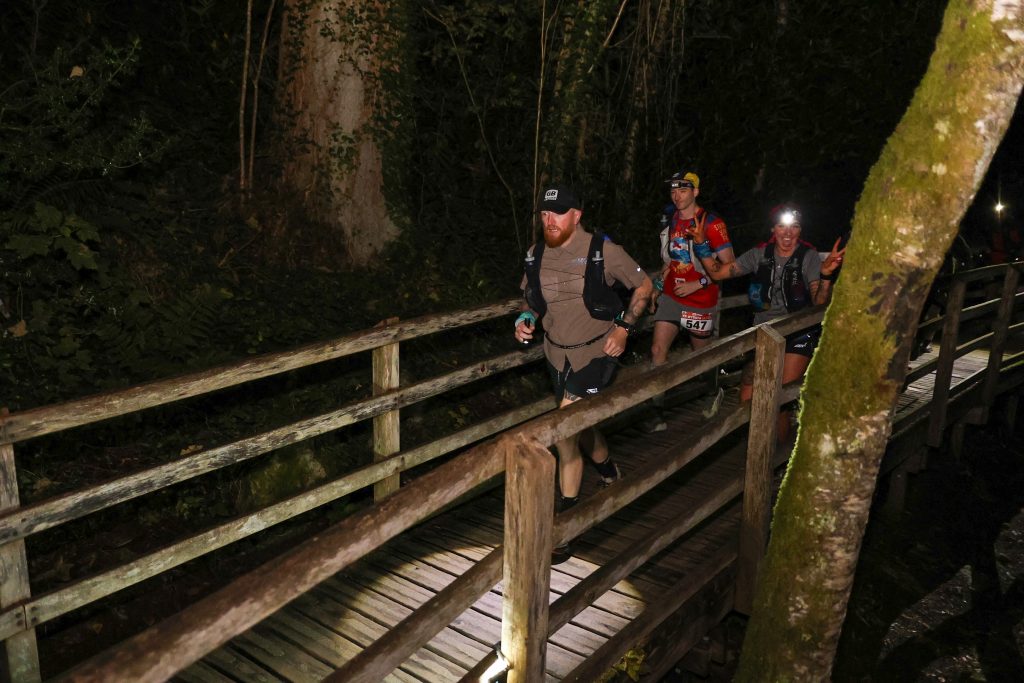
CP6 to CP7 (Penmachno Village Hall) – 50 Miles
By now it was just after 21:00 and it was pitch black. As I left the checkpoint, sandwich in hand, I took in the surreal scene, the quiet car park, my own car parked temptingly close. The urge to simply slip inside and sleep, to let the ordeal pause for a while, was almost overwhelming. But I steeled myself, reminded of the commitment I’d made, and pressed on into the night. The air was still pleasantly warm for September, with barely any wind. The sky was perfectly clear, the moon casting a soft glow that sharpened the features of the trail.
I found myself alone as I left the checkpoint, my footsteps echoing softly along the gravel tracks. The solitude was both daunting and oddly calming; I found myself hoping to catch up with other runners ahead, not just for company, but also for the reassurance of shared navigation through a notoriously tricky section. The thought of tackling the wilderness solo all night was daunting, especially as fatigue began to gnaw at the edges of my focus.
This year, CP7 was a brand new addition for 2025, thoughtfully placed to break up the previously unbroken 18-mile stretch into a more manageable pair of segments, five miles to CP7, then thirteen to CP8. I silently thanked the organisers for the change, as I’d heard tales from previous years of runners struggling with both the distance and the navigation. For me, this would prove to be the toughest section by far, as the path snaked through seldom-trodden parts of the Slate Trail, where markers were few and the way forward was often uncertain.
The route to CP7 began with a gentle, almost deceptive climb, first along tarmac roads, then onto forest tracks where the trees pressed in close, their branches arching overhead like a tunnel. My legs felt heavy with the accumulated miles, and each step was a reminder of the challenge yet to come. The isolation was profound; all I could hear was the rhythmic scuff of my shoes and the occasional rustle of wildlife in the undergrowth. The darkness made it easy to lose track of time and distance, each bend in the trail looking much the same as the last. Every so often, I’d check my watch GPS, reassuring myself that I was still on course.
After what felt like an age, a faint pulse of music drifted through the night air, at first a low thump, then gradually resolving into the unmistakable sound of party classics. Still a good 3 km from the checkpoint, the sound was oddly motivating. The likes of Pitbull and the Black Eyed Peas blared over the hills.
Eventually, I picked out two bobbing lights in the distance ahead, other runners, moving steadily if a little hesitantly through the night. Sensing the opportunity for some much-needed camaraderie, I picked up my pace and soon drew closer. As I did, I saw them hesitating at a barbwire fence, clearly having missed a stile somewhere back along the track. Making the same mistake, I followed suit, awkwardly climbing over the wire and through a patch of stubborn thorns, grateful that they’d waited for me. The minor detour served as a reminder of how easy it was to lose the way when tiredness and darkness conspired against you. Together, we found the path again, and pressed on towards the welcoming lights of CP7.
Arriving at the checkpoint, the volunteers had created a warm, inviting atmosphere inside the village hall, with soft lighting and an abundance of food and drink. I managed to eat some rice pudding, comforting and easy on my unsettled stomach, and gratefully accepted a strong cup of coffee. While I restocked my supplies, I debated whether to push out alone or stay with the others. The next segment, known for its challenging navigation and relentless terrain, loomed large in my mind. Remembering stories from previous years and the struggles I’d already faced, I decided to stick with the group. They readily agreed, and together we readied ourselves for the long, uncertain miles ahead, knowing that mutual support might just make all the difference as the night wore on.
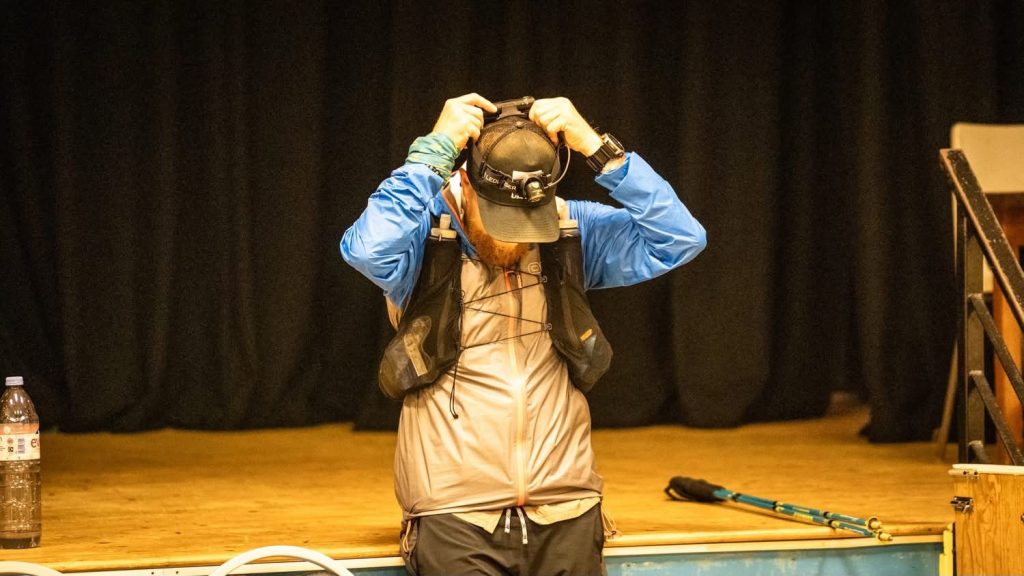
CP7 to CP8 (Neuadd Ffestiniog Village Hall) – 63 Miles
Matt and Paul, with whom I’d joined forces at CP7, had attempted the race in 2024 before being forced to DNF just a mile or so from CP8. Their familiarity with the route and, crucially, the notorious navigational pitfalls was a comforting presence as we set out together into the still-dark night. I mostly kept to myself, lost in my own physical and mental battles, but it was reassuring to have others nearby who understood the challenge so intimately.
The sickness which had been ebbing and flowing throughout the night returned with a vengeance. My stomach churned with queasiness, and the thought of eating anything substantial seemed impossible. Tiredness pressed heavily on my shoulders, dulling my senses and making every step feel laborious. My feet throbbed inside my shoes, each stride sending sharp, burning reminders of the miles already covered. The lack of solid, hot food left me feeling hollow and weak, my energy reserves running dangerously low. Running was out of the question; I was reduced to a slow, determined trudge, placing one aching foot in front of the other, my focus narrowed to the patch of earth illuminated by my headtorch.
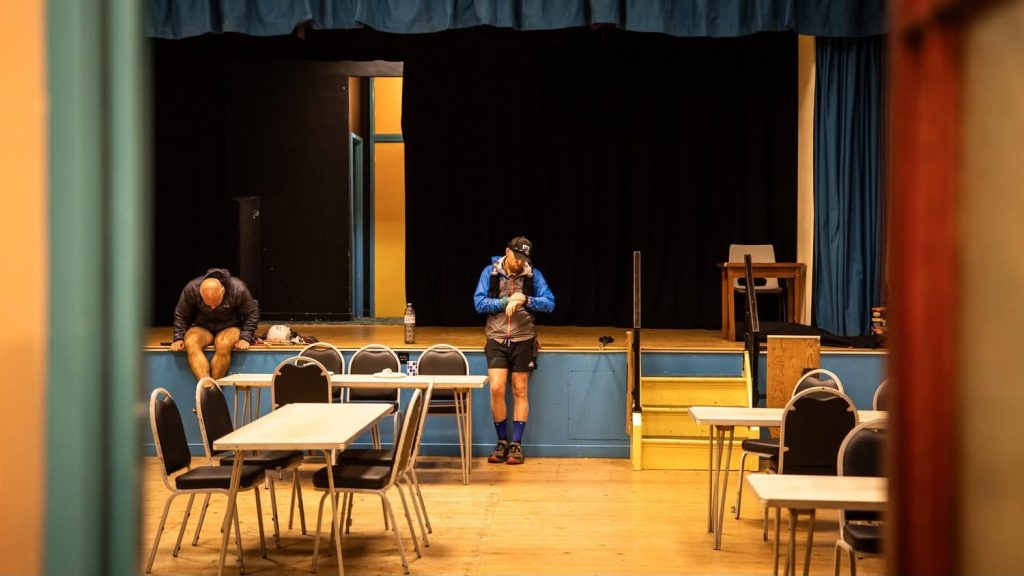
The hours that followed were a test of sheer willpower. Every so often, we’d catch up with three or four other runners, each moving in their own weary bubble. We passed and re-passed each other, taking turns at the front, each of us making the occasional navigational error. The route was a twisting labyrinth of indistinct footpaths, with markers few and far between. The darkness made it almost impossible to judge distance or time.
We passed through a couple of small, sleeping villages, each one a brief beacon of hope that maybe, just maybe, the next checkpoint was near. But each time, our hopes were dashed, and we pressed on, spirits flagging. Time seemed to stretch and warp; the minutes dragged endlessly, and the miles felt twice as long as they should. The isolation and fatigue gnawed at my motivation, and several times I questioned whether I could actually keep going.
Eventually, after what felt like an eternity, we spotted the faint glow of lights signalling the approach to CP8. Relief washed over me as we trudged into the Neuadd Ffestiniog Village Hall, grateful that the checkpoint was indoors and offered a brief respite from the relentless night. I found a chair, collapsed into it, and peeled off my shoes and socks, relishing the cool air on my battered feet. Setting the alarm on my phone for 30 minutes, I folded my arms on the table, laid my head down, and closed my eyes, desperate for even a few moments of rest. My body ached, my mind was foggy, and I felt emotionally wrung out, this was the lowest point I’d experienced, not just in this race, but possibly in the entire grand slam series.
My alarm sounded. I forced myself upright, feeling no better than before, and was greeted by Glen, the checkpoint lead, who placed a cup of coffee and some cheese on toast in front of me. The simple meal felt like a lifeline, warm, salty, and easy to digest. I changed into fresh socks, though the relief was only fleeting, and sat there, wallowing in a mix of self-pity and dread. Glancing at the time, I realised I was only an hour ahead of the cutoff, a dangerously slim margin, and the closest I’d ever come to missing it.
As I gathered myself, I noticed a small mountain of trackers piled on the desk, silent testaments to those who had already called it a day, their races cut short by the sheer difficulty of this section. It was sobering to think how many more would inevitably add theirs to the pile before the checkpoint closed. The weight of fatigue and doubt was immense, but as I forced myself upright and began to repack my bag, I clung to the hope that the coming sunrise would bring renewed strength. I stepped out of the hall, determined to push on, hoping that daylight would offer the boost I so desperately needed to reach the finish.
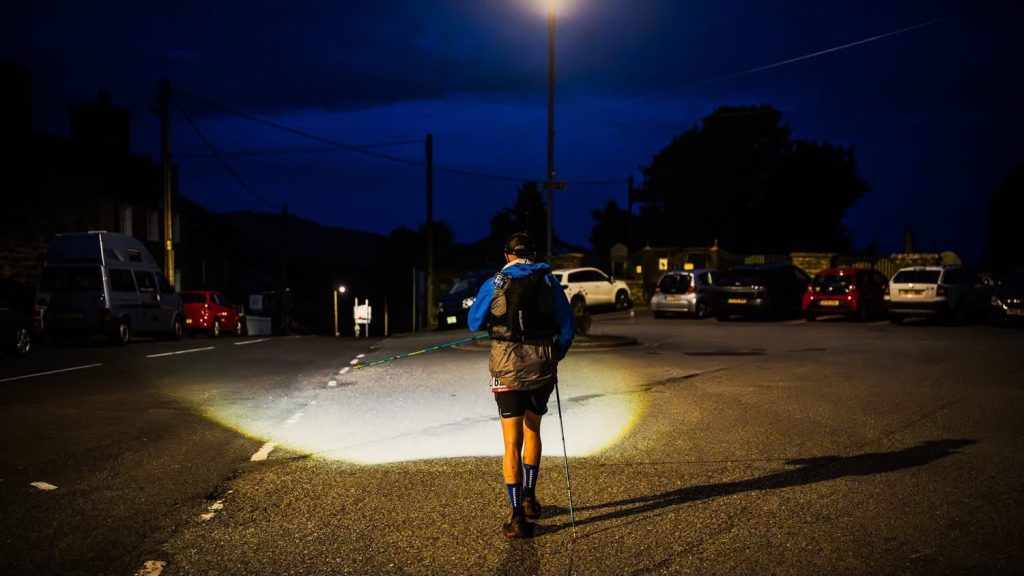
CP8 to CP9 (Croesor Car Park) – 73 Miles
Leaving the welcoming warmth of Neuadd Ffestiniog Village Hall behind, I stepped out into the pale light of early morning, the chill in the air a sharp contrast to the comfort I’d just experienced. My body felt battered and heavy, but the prospect of daylight brought a cautious hope. The path initially wound through Blaenau Ffestiniog, a town still mostly quiet at this hour. As I shuffled through near-empty streets, I glanced up at the looming mountains, their peaks now visible after the long, oppressive darkness.
Spotting a Morrisons Local that was open, I ducked inside, grateful for the opportunity to restock and grab something cold to drink. The Mountain Dew I bought was sweet and bracing, its sugar and caffeine providing a much-needed jolt to my system. Sipping it as I walked, I could feel my spirits starting to lift.
With renewed determination, I pressed onwards, leaving the town behind and following the trail as it began its steady ascent out of Tan-y-grisiau. The climb was steep and relentless, winding up through rocky outcrops and patches of stubborn grass. My legs burned with effort, but I found a rhythm and powered upwards, overtaking a handful of other runners who were labouring under the strain. The higher I climbed, the broader the views became.
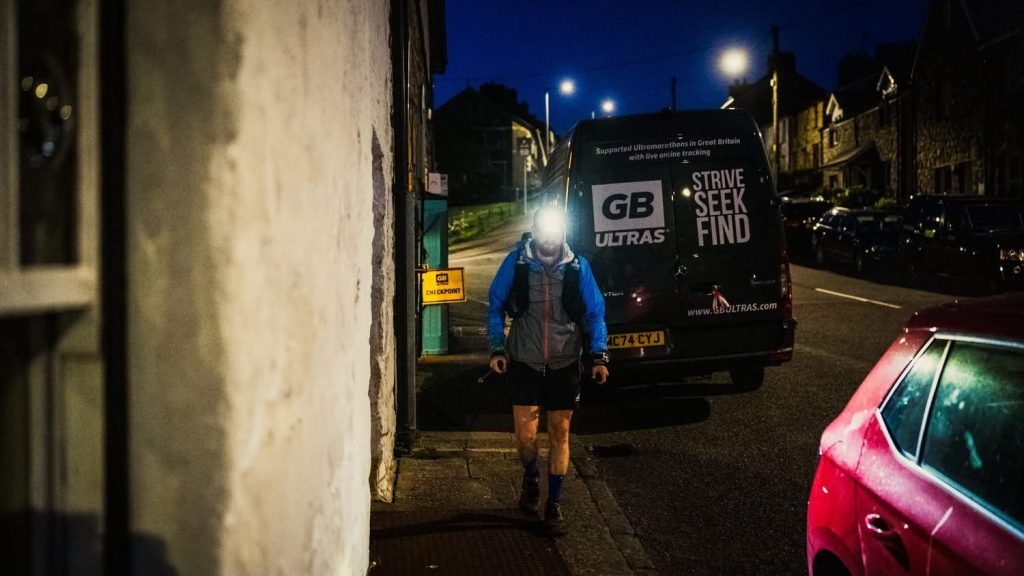
At the top of the climb, a cool breeze greeted me. For the first time in hours, I felt a surge of confidence returning. The fatigue and nausea hadn’t vanished, but they were now background noise rather than the main event. I started to move more fluidly, overtaking more runners as I found my stride on the undulating trail.
Soon, I reached the start of a long, technical descent, where the rocky path twisted down towards Croesor. Here, I encountered Oli, who was also making good progress. We exchanged a few words, short, slightly breathless encouragements, and then fell into step together. Descending was oddly easier than walking; the pain in my foot, which had flared up while hiking, subsided somewhat when I picked up the pace and focused on running. The two of us navigated the descent in companionable silence, finding motivation in each other’s presence as the trail wound its way through woodlands and past the occasional farmhouse.
Arriving at CP9, Croesor Car Park, felt like another small victory. Volunteers greeted us with smiles and the promise of hot drinks and food. I gratefully accepted a mug of tea and managed to eat a little more than I had at previous stops, some biscuits and cake, which settled easily for once. There was a palpable sense of progress, the miles were ticking by, and the finish line, while still distant, now seemed within reach. As I sat and regrouped, I reflected on the night’s trials and the unexpected boost provided by the sunrise and a simple bottle of fizzy drink. With my morale higher and my energy somewhat restored, I readied myself for the next stretch.
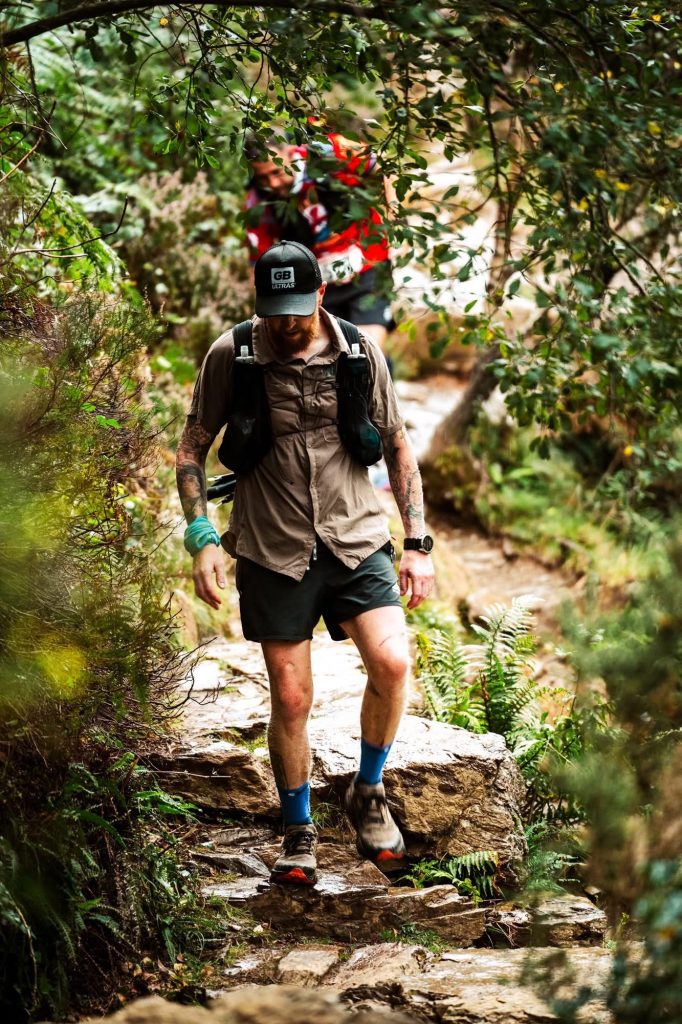
CP9 to CP10 (Beddgelert Community Hall) – 78 Miles
Setting out from Croesor Car Park with Oli, the transition to the next section felt almost serene compared to the night’s earlier hardships. The trail initially offered gentle terrain, and the morning air was fresh. Oli and I settled into a comfortable rhythm, sometimes moving quietly, each lost in our own thoughts, and at other times swapping stories and words of encouragement. We took turns at the front, each spurring the other on whenever fatigue threatened to slow our pace. The companionship was a welcome boost, helping us forget the aches in our legs and the growing tiredness in our bodies.
As the path meandered closer to the river, the ground became more uneven, with roots and stones demanding careful footwork. The area was noticeably livelier, with families and dog walkers making the most of their weekend, their cheerful chatter and laughter providing a brief distraction from the relentless monotony of the ultra. Navigating the busy stretch required us to weave around groups, sometimes stepping aside to let dogs pass or exchanging nods with fellow walkers.
Despite the busier atmosphere, the section felt uneventful in terms of drama; Oli and I simply kept our heads down, focusing on maintaining a steady pace. Every so often, we overtook other runners, some looking just as worn as we felt, all of us united in the silent determination to reach the next checkpoint. There was a quiet camaraderie among those on the trail, with brief exchanges of encouragement and knowing looks that spoke volumes about shared endurance.
Arriving at CP10, Beddgelert Community Hall, was a relief. I was greeted by the sight of my second drop bag and fresh supplies and dry gear. I methodically replenished my snacks and fluids, swapping out my damp socks for a clean pair, savouring the simple comfort they provided. Light rain had begun to fall, but the temperature remained warm enough to keep spirits up. Anticipating the changeable Welsh weather, I packed an extra top, just in case the rain turned heavier or the temperature dropped.
Volunteers offered hot drinks and food, and I gratefully accepted a cup of coffee and some cheese on toast. The warmth of the food was restorative, settling my stomach and lifting my mood. Around me, other runners regrouped, some stretched tired muscles, others caught up with friends or quietly prepared for the next stage. After a brief rest, feeling refuelled and somewhat rejuvenated, I set myself for the journey ahead, determined to keep moving forward no matter what the weather brought.
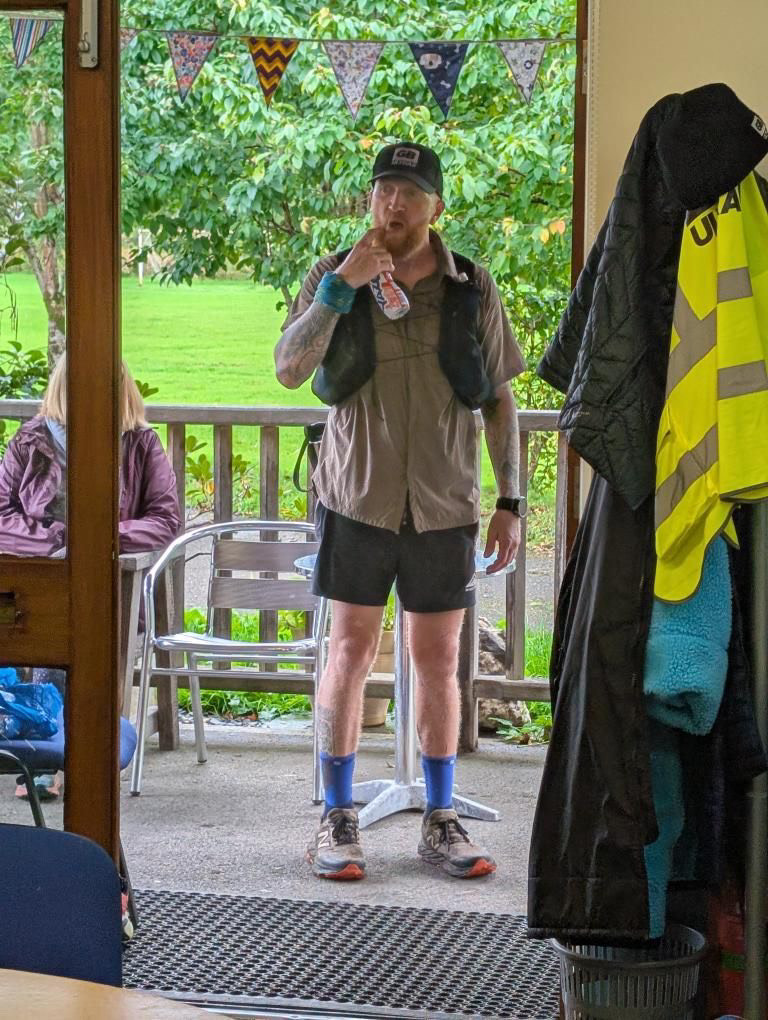
CP10 to CP11 (The Pavilion, Rear of Ysgol Dolwyddelan) – 90 Miles
Setting out from CP10, I felt surprisingly rejuvenated, as if the previous hours of exhaustion had shifted to the background. The rain had eased to a light drizzle. We joined the well-trodden Slate Trail, which hugged the edges of two lakes. Despite the growing fatigue, I found a consistent rhythm, my legs turning over smoothly as we overtook several other runners who had slowed to a walk. Each overtaking felt like a small victory, and I started to believe I could claw back some of the time I had lost during the gruelling night section.
To my left, Snowdon loomed, its summit shrouded in cloud. Spotting the familiar outline lifted my spirits, reminding me of previous adventures on these trails. I recognised the junction with the Watkin Path, recalling the punishing climb from the UTS100 earlier in the year. The rain intensified temporarily, but I pressed on, the cold drops invigorating rather than discouraging. The trail began to rise, the surface giving way to open marshland dotted with tufts of stubborn grass and pools of standing water. My shoes were soon sodden, but at this point, discomfort was just part of the experience. Oli, began to fall behind on the ascent, preferring to tackle the climb at his own pace. I pushed on alone, motivated by the thought of nearing the end of this epic journey.
The wind picked up as I crested the high ground, swirling rain into my face and reducing visibility. The landscape felt wild and exposed, just me against the elements, with nothing but the sound of my own breathing and the squelch of my footsteps for company. The descent into Dolwyddelan was long and technical, the path slick with rain and scattered with loose stones. Concentration was crucial; a wrong step here could mean disaster so close to the finish. Despite the challenging conditions, my legs responded well, and I maintained a strong pace, overtaking a few more runners who were picking their way down cautiously. My foot, which had troubled me intermittently throughout the race, seemed to ease off whenever I kept moving, so I was determined not to stop and risk it stiffening up.
As the village of Dolwyddelan came into view, nestled beneath steep, wooded hills, a surge of relief came over me. The final checkpoint was a hive of activity, with volunteers offering words of encouragement and trays of food and hot drinks. I paused only briefly, not wanting to lose momentum or let my muscles cool down too much. I gratefully accepted slices of orange and banana, along with a mug of tea. Knowing that the finish was now just a couple of hours away, and that I was well ahead of the cutoff, I wasted no time. With a quick thank you to the volunteers, I set off into the rain, determined to make these final miles count.
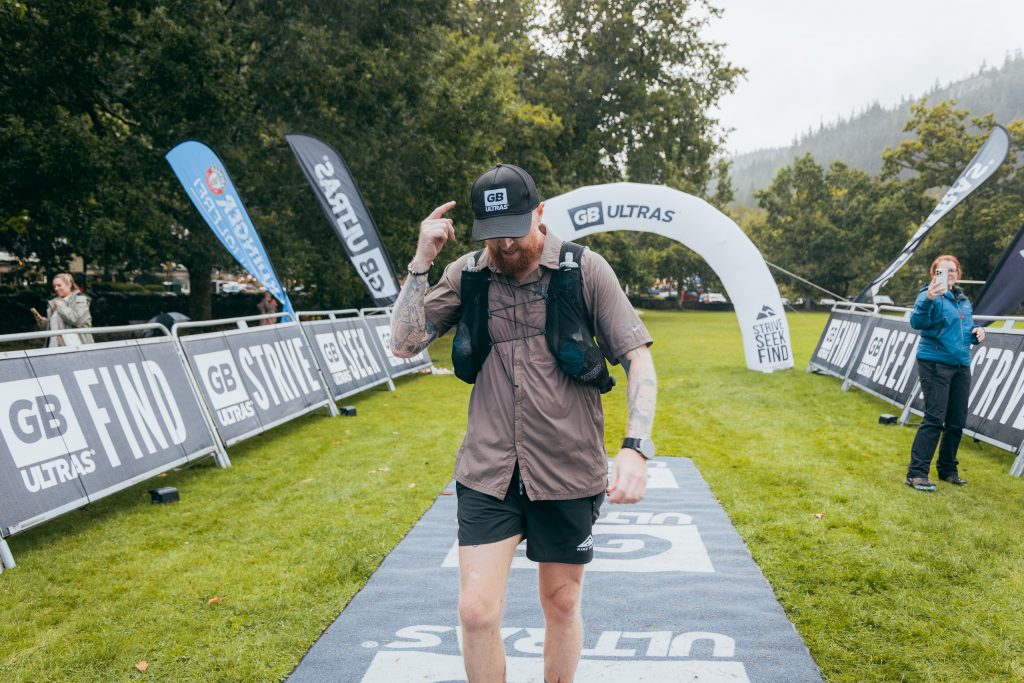
CP11 to Finish (Betws-y-Coed Village Green) – 100 Miles
I left the final checkpoint on an unexpected high, buoyed by the warmth of hot drinks, words of encouragement from volunteers, and the palpable sense that the journey was almost complete. The rain, which had settled into a relentless, drenching downpour, seemed almost irrelevant at this point. The sky was grey, the clouds hanging low and heavy.
The forest track that marked the last climb wound steadily upwards, its surface slick with puddles. I settled into a determined power hike, planting each pole firmly and driving myself forward with the thought of finally finishing this race. Despite the fatigue in my legs and the stinging rawness of my feet, now well past the point of caring about the damp, I found my mind wandering to thoughts of celebration, visualising a hot meal, a well-earned drink, and the sweet relief of sitting down with my family.
Emerging from the dense woodland, the trail spilled out onto open moorland. Here, the wind bit through the wet fabric of my kit, and vast puddles, verging on shallow lakes, had formed across the exposed ground. My shoes were completely saturated, and I could feel the skin on my heels and toes beginning to prickle with the early warning signs of blisters, but I pushed on. I kept a sharp eye on my footing, choosing my steps carefully to avoid the worst of the waterlogged ground, knowing that one careless slip could cost me dearly this close to the finish.
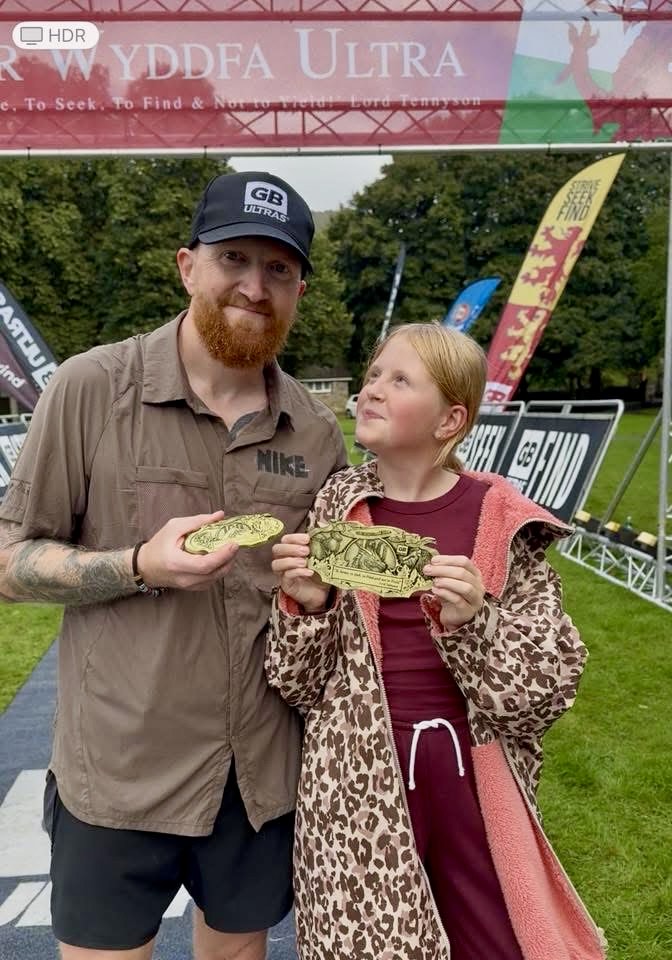
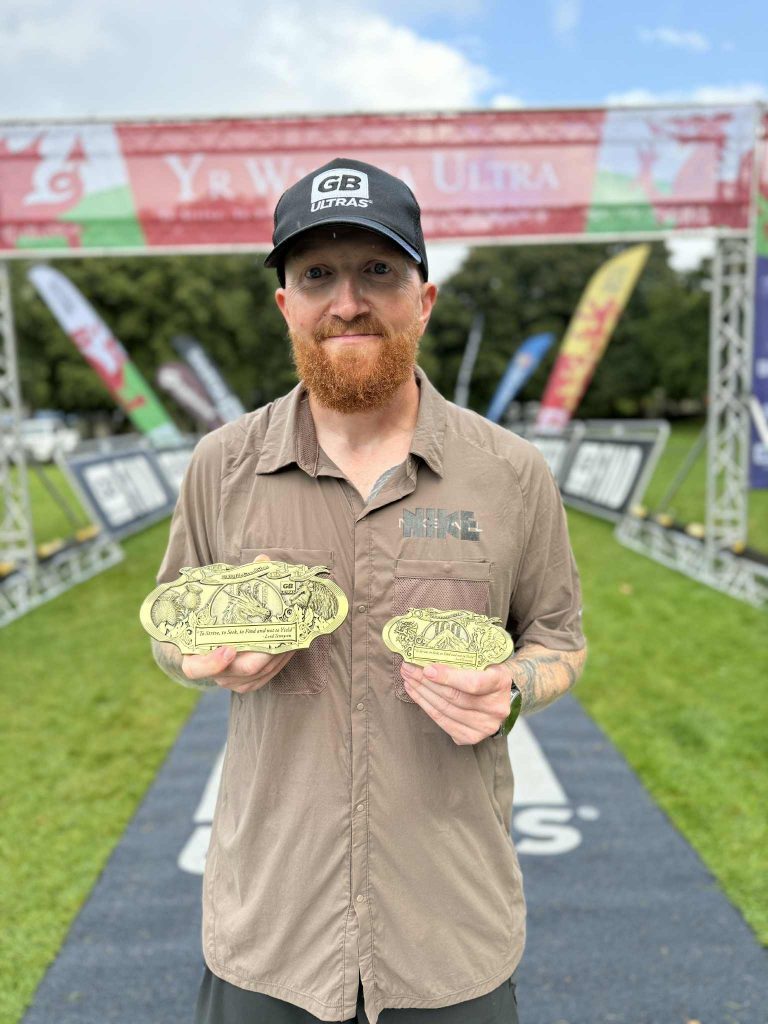
The descent from the moorland was steep and technical, the path winding downwards through tangled roots and mossy rocks, which the rain had rendered treacherously slippery. My thighs burned with the effort of controlling each step, but gravity was on my side now. Passing through a break in the trees, I suddenly found myself on the verge of the A5, the main road leading directly into Betws-y-Coed. The sight of familiar tarmac after so many miles of wild trail was oddly comforting, marking a return to civilisation and the final approach to the finish.
I broke into a steady run along the roadside, trying to ignore the ache in my hips and knees. The road shimmered with surface water, reflecting the headlights of passing cars as Sunday afternoon traffic began to pick up. As I neared the turn-off back towards the river, I spotted the medic team who had been a reassuring presence throughout the race. We exchanged fist pumps, their broad grins and shouts of “well done!” spurring me on. They directed me up a short, sharp climb to rejoin the trail, reminding me that the finish was almost in sight.
Rejoining the familiar path, I recognised the exact spot where, just the day before, the 50-mile runners had sped past me, full of energy and determination. The pain, persistent, nagging, sometimes sharp, was suddenly eclipsed by a tidal wave of joy and disbelief. After everything, I was still moving well, legs turning over almost effortlessly as if fuelled by sheer willpower.
The approach to the boardwalk, which signalled the final stretch, was surreal. The wooden slats were slick underfoot, but I barely slowed, crossing the bridge and into the village. The distant sounds of applause grew louder as I entered Betws-y-Coed, and the sight of locals and tourists alike, sheltering under umbrellas yet still clapping and cheering, made the moment all the more special. Their encouragement carried me through the village. I ran through with a silly big smile on my face. As I ran onto the village green I spotted my family, cheering me on, I crossed the finish line, overwhelmed by emotion. I had done it.
Memories of the darkest moments, of near collapse, of relentless self-doubt, of fighting through pain and weather, flashed through my mind, making this achievement all the more meaningful. I had journeyed to my breaking point and back, discovering reserves of determination I never knew I possessed.
In the end, all the grit and effort of the previous 40 miles paid off. Not only had I clawed back over three and a half hours from the dreaded cutoff, but I had also completed the coveted grand slam, a feat achieved by just four runners this year.
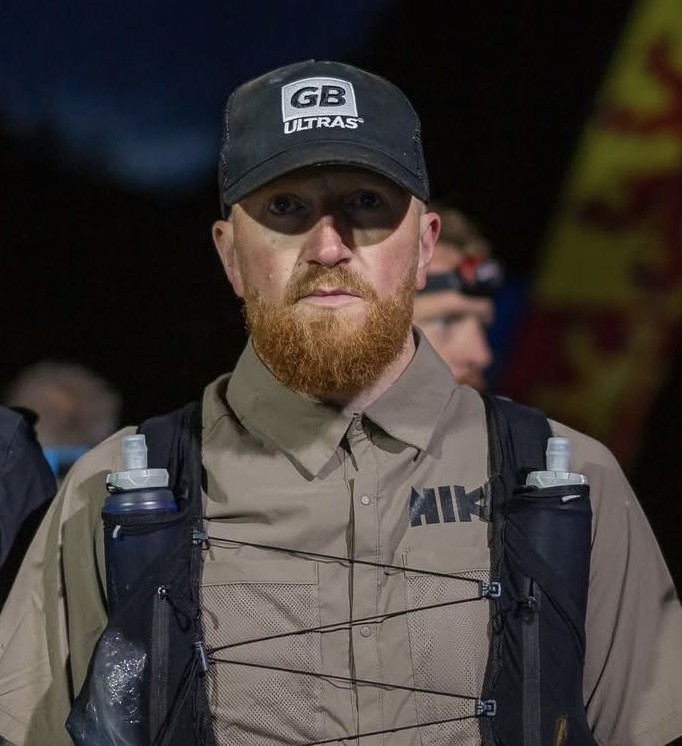
The Stats
Total Distance: 166km / 104miles
Total Elevation Gain: 6,702m / 21,988ft
Total Time: 35 hours 42 mins
Total Calories burned: 16,222cal
Avg. Pace: 10:23/km Avg. HR: 129bpm
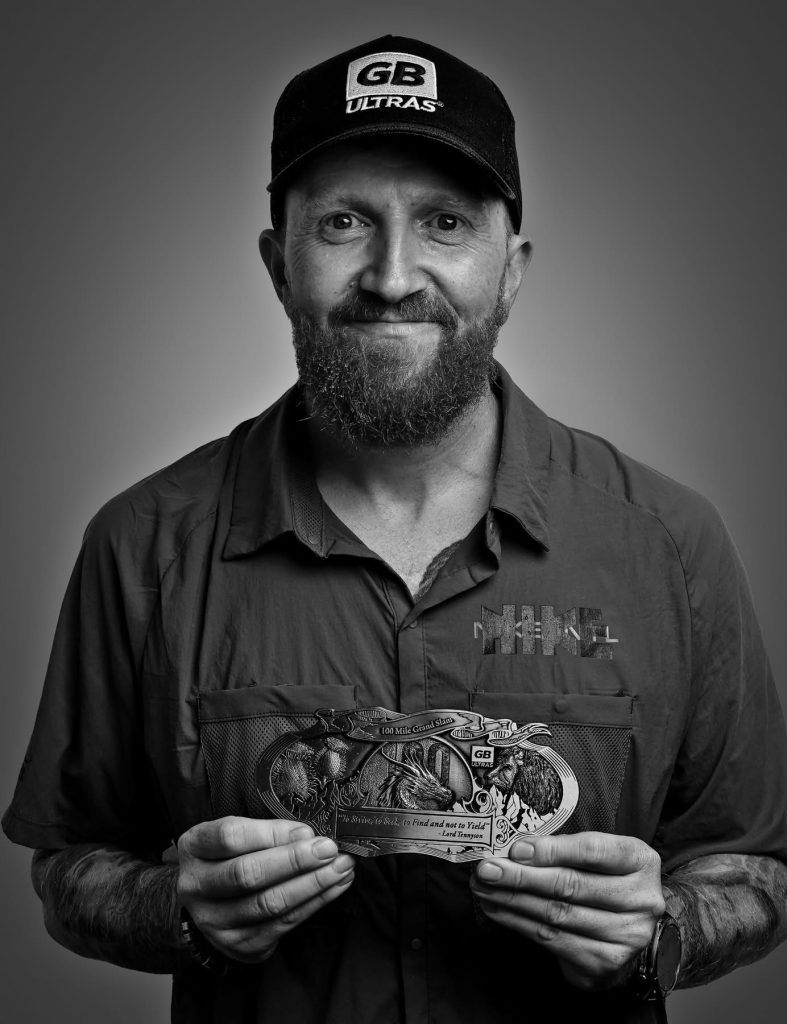


Leave a Reply